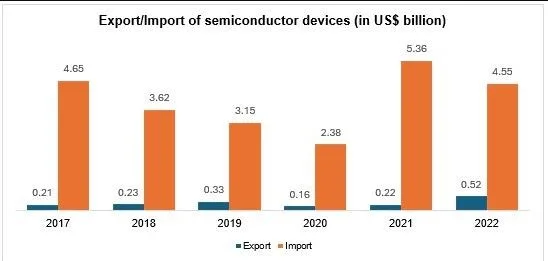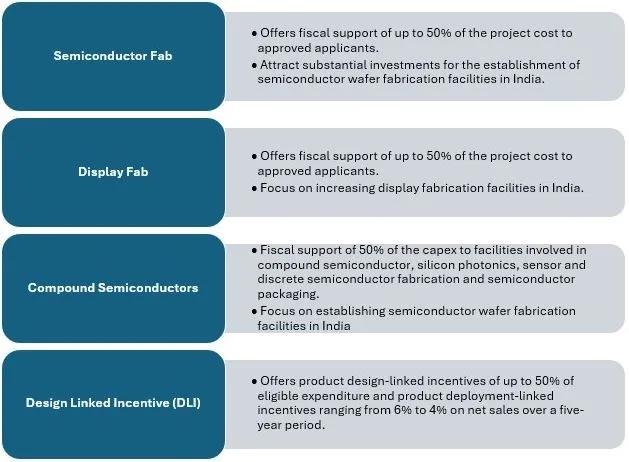Syllabus: GS3/Economy
Context
- US announced a “new partnership” with India to explore semiconductor supply chain opportunities.
About
- It will include a comprehensive assessment of India’s existing semiconductor ecosystem, regulatory framework, workforce and infrastructure needs.
- It will serve as the “basis for potential future joint initiatives” to strengthen and grow this critical sector.
- The US Department of State will partner with the India Semiconductor Mission, to explore opportunities to grow and diversify the global semiconductor ecosystem under the International Technology Security and Innovation (ITSI) Fund, created by the CHIPS Act of 2022.
- The Creating Helpful Incentives to Produce Semiconductors (CHIPS) and Science Act is intended to lure microchip manufacturing back to the US after decades of companies offshoring the technology.
What are Semiconductors?
- Semiconductors are materials with electrical properties that fall between those of conductors (like metals) and insulators (like rubber).
- They have a unique ability to conduct electricity under certain conditions while acting as insulators under others.
- They are sometimes referred to as integrated circuits (ICs) or microchips made from pure elements, typically silicon or germanium.
- In a process called doping, small amounts of impurities are added to these pure elements, causing large changes in the conductivity of the material.
- Applications: Semiconductors are used in a vast range of electronic devices.
- Transistors, which are fundamental components of modern electronic circuits, rely on semiconductor materials.
- They act as switches or amplifiers in everything from computers to cell phones.
- Semiconductors are also used in solar cells, LEDs, and integrated circuits.
India’s Semiconductor Industry
- In 2022, the Indian semiconductor market was valued at US$ 26.3 billion and is projected to expand at a CAGR of 26.3% to US$ 271.9 billion by 2032.

- Semiconductor devices include diodes, transistors and photovoltaic cells assembled or not assembled in modules or panels, light-emitting diodes (LEDs) and mounted piezo-electric crystals.
Factors favouring India
- Skilled Workforce: India leads the world with record number of Science, Technology, Engineering and Mathematics (STEM) graduates, offering the much-needed skilled workforce required in semiconductor manufacturing, design, research, and development.
- Cost Advantage: India offers a substantial cost advantage for semiconductor manufacturing due to the lower labour cost, supply chain efficiency and emerging ecosystem.
- Global Supply Chain Diversification: India has become a preferred destination for back-end assembly and testing operations amidst this industry relocation, with potential for future front-end manufacturing.
- Policy support: The Indian government has promptly seized the opportunity following the global semiconductor supply chain glut after the pandemic and showed great intent through policy support to present India as an alternative to China in the global semi supply chain.
India’s Semiconductor Ecosystem
- Supply disruptions during the Covid-19 pandemic and the geopolitical tensions arising out of China’s aggressive moves in the Taiwan Strait and the South China Sea have brought urgency to India’s efforts to develop its own semiconductor ecosystem.
- The global chip industry is dominated by companies from a very small number of countries, and India is a late entrant into this high-tech and expensive race.
- India Semiconductor Mission: It functions as a dedicated division within the Digital India Corporation.
- Its main goal is to nurture a strong semiconductor and display ecosystem to position India as a prominent global player in electronics manufacturing and design.
- Under ISM, there are several schemes in place:

- The government offers incentives for manufacturing setup in India:
- Under the Semiconductor Fab Scheme, fiscal support of 50% of the project cost on an equal footing for all technology nodes.
- Under the Display Fab Scheme, fiscal support of 50% of the project cost on an equal footing basis.
- Under the Compound Semiconductor Scheme, fiscal support of 50% of the capital expenditure on an equal footing basis, including support for discrete semiconductor fabs.
- In February 2024, the government approved the establishment of three semiconductor plants, two in Gujarat and one in Assam.
Conclusion
- Taiwan produces more than 60 percent of the world’s supply of semiconductors and more than 90 percent of the most advanced chips.
- Given the critical importance of semiconductor chips in almost everything, from missiles to mobile phones and cars to computers, the partnerships with the US have geo-strategic and geo-economic importance.
Source: IE
Previous article
India and UAE MoU for Nuclear Cooperation
Next article
New Machine Safety Norms to Affect MSMEs